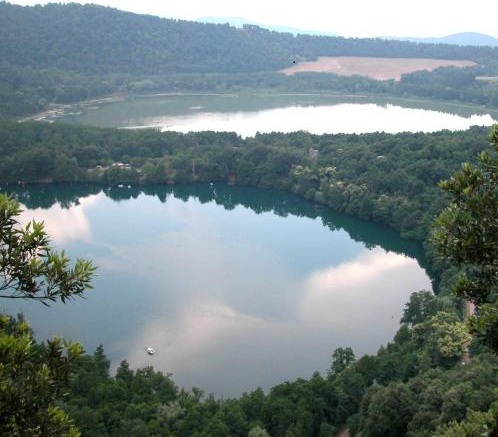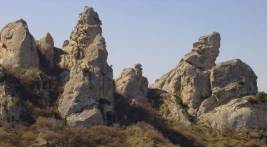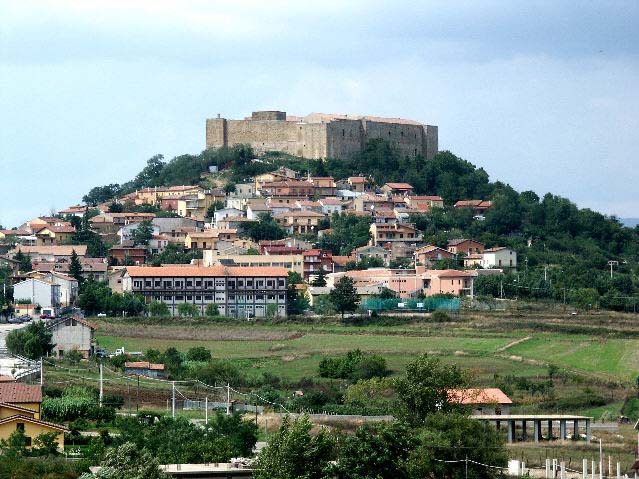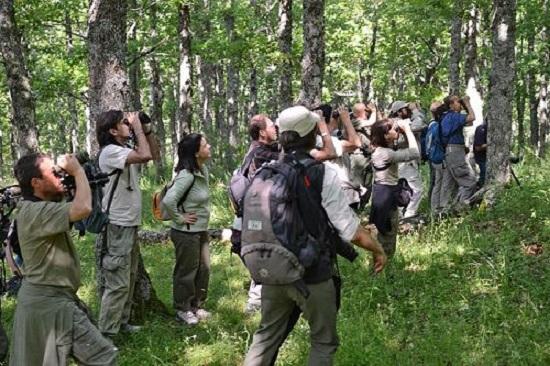
FOR WANT OF A TREE THE KINGDOM WAS LOST
By: Tom Frascella September 2013
I selected the above title for this article because I feel it highlights that when viewing history in hindsight events which at the time of occurrence seem unrelated sometimes connect in surprising ways. As I discussed in earlier articles the Bourbon Monarchy of southern Italy’s early 1800’s was violently displaced by Napoleon Bonaparte’s forces. Napoleon replaced the Bourbon’s in Naples with first his Brother and then his sister and brother-in-law. The Bourbon King fled after the French takeover to Sicily supported in exile by the British navy.

King Ferdinand II King of the Kingdom of the Two Sicilies 1830-1859
After the defeat of the Napoleonic forces in 1816 the Bourbon Monarchy was restored and the government became known as the Kingdom of the Two Sicilies. While the Bourbon’s had managed to flee to Sicily with a good deal of the national treasure, the resources and treasury of southern Italy were badly looted by the French during their period of occupation.
Upon its reinstatement the Bourbon Monarchy found that it needed to replenish the national treasury. As I have previously written the period 1826-1855 saw a real attempt by the government to increase southern Italy’s manufacture and international trade. Increasing manufacturing and producing trade goods for exchange require increased use of raw materials. Southern Italy is in short supply of such natural resources but to the extent they existed they were to be found in the interior of the Kingdom both on the mainland and in Sicily. Manufacturing and the ports which would benefit the most from the supply were located along the coastal plains of the Kingdom.
Most of the land and natural; resources of Southern Italy in the interior was owned by either the Church or wealthy absentee landlords. The average peasant Lucanian and Sicilian farmer had for generations worked the land of others or cared for the herds of others receiving low wages or a small portion of the produce in return for their labor. However, with the sudden push to harvest the natural resources of the land these farmers would see the society in which they lived greatly diminished.
In this article I will focus on the Lucanian experience and will save the Sicilian experience for a later article. Again as I have previously written Europe and the world experienced a climate change which negatively effected crop production in the northern regions of Europe and America from the mid 1700’s to the mid 1800’s. As a result northern Italy had taken advantage of the increase in wheat futures and greatly increased its grain production. Starting in the 1830’s the Bourbon government sought to do the same thing in the south. One region that the Bourbon government saw as underutilized for farming was the forest covered mountains and hillsides of Lucania.
Lucania is classified as composed of 84% hills and mountains. For centuries its primary agricultural activity was herding and the by-products of herding hides, wool, meat, cheeses etc. The hills and mountains were covered in ancient forests, like those below with its population living off the land in very small towns and villages. The economics, culture, diet and social structure developed over millennia in Lucania was based on agro-herding.

Lake Piccolo and Lake Grande in the crater of Mt. Vulture

Dolomiti Lucani rock formation

Castle Lagoposole

Forest of Grancia with eco-tourists
The above photographs give some insight as to how the whole Lucanian region appeared prior to deforestation however starting around 1830 the powers to be saw an opportunity to cash in on this natural resource. As we stated most of the land was owned by the Church or large absentee landlords. First the forests were cut down, clearing the land and creating in the forests’ demise a cash crop for the landlords in timber as a commodity for building, furniture making, milled lumber for export and for use as fuel. The forests were replaced with terrace farming. In the span of a single generation the region was changed beyond recognition.
Because the town of San Fele is located in the northern part of Lucania I will concentrate this article’s references there although the same story applies throughout the region. In 1820 before the deforestation began the northern province of Lucania was sparsely populated and had a population of between 180,000 and 200,000. Cutting down forests and transporting the lumber to the coast was difficult in the mountainous terrain of Lucania. It was also very labor intensive. Creating terrace farming was likewise labor intensive and difficult. In the early stage of this transformation of the region cheap manual labor was needed to exploit the harvest its natural resources. Rural families were encouraged to have more children and in just one generation 1830-1850 the population of northern Lucania grew from 180,000 to 250,000. This may not seem like a lot but it is a 38% increase and a distortion of the population dynamics to a high percentage of youth. As we see, wherever disproportionate growth favoring youth there are major social implications that follow. That great changes would occur became readily observable in Lucania pretty quickly
Since the local poor did not own the land when it was cleared or the pastures were plowed herding decreased very rapidly. A way of life that had sustained the poor disappeared within a generation. At first his may not have seemed critical as the continuing forest harvest and conversion of the land to crop production more than filled the employment situation. The poor herdsmen became either tenant farmers in reality sharecroppers or what Italians call “woodcutters” which we understand to be lumberjacks.. The mountainous land by nature is rocky and poor yielding. Once the forests which protected the soil from erosion were destroyed consequences to the destruction began to occur. Each year the soil eroded and the yield lessened. In addition a new natural occurrence began to appear on the local scene with regularity, massive destructive life taking mudslides.
The 1830’s to 1850’s deforestation and wheat production also had a profound impact on the local diet. Although I intend to write many articles on this subject in the future I feel I need to make some reference to this subject here. An appreciation that the deforestation changed both pre deforestation traditional diet and style of cooking should be appreciated. As herdsmen living in heavily forested locales the peasant herdsman could maintain small gardens for vegetables, and could grow enough grain for local consumption. They could supplement their diets with local cheeses, milk, meat and natural produce and from the forests additional food opportunities, hunting, mushroom picking etc could be found. Their diets and cuisine reflected the diversity of natural resources available to them. Once the deforestation of the land occurred their diet became much more grain dependent, far less meat, cheese and vegetables were available for daily consumption. Cheese, preserved meats and vegetables became, little more than a garnishments on simple flour based dishes. Beans began supplying the major source of protein in the local diet. With the shift in land use, 1830-1850, a second phase of the Lucanian cuisine/diet started to develop. This style of cooking and dietary content will feature strongly in the earliest Lucanian immigration to the U.S which will begin in the mid to late 1850’s.
I think it is interesting in U.S. records dating back before 1950 I have never found a reference to dishes or cooking style identified as either Lucanian or Basilicatan in origin. If you go on the internet today however, you can find references to the Lucanian or the Basilicatan style of cooking, in fact there are even cooking tours of the region where tourists stay at local farming bed and breakfasts and learn local cooking and recipes. But this is a recent “foodie” development. In the mid 1900’s in America all dishes identified with Italian cooking were simply Italian. It generally wasn’t until around 1970 that people in this country started discussing Italian food as either Northern or Southern Italian. Of course Italians have always recognized regional distinctions in their cooking after all Italy is a place where it makes sense to have a thousand different shapes of pasta and it is believed that each shape is better for a particular use. More recently many much loved and often consumed forms of Italian cuisine started being recognized as Neapolitan. Lucanian dishes were usually placed in this “Neapolitan” group and from there slowly these dishes began being referred to as “rural” or “rustic” Neapolitan cuisine. Cuisine, like many other aspects of the Lucanian-American experience, was not distinctly recognized as Lucanian in part because Americans and many Italians had never heard of Lucania. As a result many Lucanians were simply identified in American texts as Neapolitan.
After going through all of the time and back breaking effort to convert the Lucanian highlands to wheat farming a strange thing occurred. In the late 1840’s another global temperature shift occurred and the northern latitudes warmed by a few degrees. This helped stabilize northern growing seasons allowing them to increase grain production and decrease foreign dependence. Wheat futures dropped in the southern latitudes and the weather pattern also shifted and became slightly drier. 1847 saw an extremely poor harvest which impacted the peasant sharecropping farmer drastically.
1848-1853 saw another “Carbonari” based independent flare-ups of revolt occur throughout Italy including the Bourbon Kingdom of the Two Sicilies. As we discussed in previous articles the Carbonari revolts were primarily lead by middle class individuals seeking greater liberties and constitutional guarantees for property and civil rights. For the peasant farmer the series of revolts staged over decades had little or no attraction as success offered no hope of improvement to their lives. The revolt of 1848-1853 was the best planned and best coordinated of the Carbonari revolts to date. In fact the revolts for a short time were successful in central and northern Italy and established a brief lived republic. A very different situation occurred in the Bourbon Kingdom of the Two Sicilies. In the south the Carbonari had arraigned for a small well equipped force to secretly sail from the north to the Kingdom land and seek to rally the various factions into a cohesive anti government force. The Bourbon monarchy had the best trained and equipped Italian land force in existence at the time numbering about 100,000 men. However whether the force could have persisted against a unified rebel force will never be known. That is because the small secret Carbonari landing force was met literally as they landed, defeated and the leaders hung. The Carbonari in the south were stunned and clearly they understood that for interception to have occurred their cause had have been betrayed. The fractured rebellious elements in the south remained that make them easily and brutally defeated by the Bourbon forces. Among those subject to the wrath of the bourbon forces were many Carbonari from the County of Melfi of which San Fele is a part.
It was eventually determined that in the early planning stages of the 1848-1853 revolt the Carbonari leader Mazzini was in exile in England. In touch with his network of fellow Carbonari he corresponded by coded correspondence from his apartments in London regarding the planning of the military thrusts of the up coming campaign. What he did not know, as he considered the British as allies, was that British Intelligence was intercepting his correspondence and had broken his code. It was the British government that alerted the Bourbon Monarchy to the exact date, time and place of the landing insuring that as to southern Italy the Bourbon Monarchy would retain control and that the rebellion would be crushed. This begs the question why was the British government so keen on preserving the Bourbons in power. That is a topic that will be discussed in a later article this year and primarily involves a strategic resource not located in Lucania.
As for Lucania by the end of the revolt in 1853 we could sum up the situation as most of the forest land was gone, a way of life that had existed for millennia was gone, a cash crop was greatly diminished in value, a vastly underemployed peasant labor force had swelled in numbers and the rebelling elements of the small middle class had been crushed. Not much hope and a real possibility that things would get considerably worse.
You have to wonder what were these people thinking.
Fortunately, we start to get a clue of how and what the people of the region were thinking from an interesting source the Italian writer Carlo Levi. Carlo Levi was an Italian Jewish doctor who was born in Northern Italy. Politically in the 1920’s he was vocally anti fascist. This earned him exile in the worst place Mussolini could think to send a fellow Italian, Basilicata. During his time in Basilicata, the poorest part of Italy he became well acquainted with the culture and history of the region. Levi became fascinated with this region that previously little, if anything, had ever been written. He would begin to write about the region including his most famous work titled “Christ stopped at Eboli”.
In the 1947, after his breakthrough work had been published Dr. Levi was invited by “Life” magazine to do a guest piece which was published in July of that year. The article was titled “ Italy’s Myth of America”. I invite those interested to read the article but for my purposes here I want to quote from the article a small note that Dr. Levi attributes to a village official from greater Lucania, in the modern Abruzzi region the village of Vasto to the Bourbon Minister of the Interior in the year 1853. The note reads;
Your Excellency: His Majesty’s faithful subjects beg to inform
Your Excellency that the woods that belong to both charitable institutions
And private individuals are being cut down and the land cleared for
cultivation, to the detriment of our pastures. For lack of firewood the
Undersigned and all other inhabitants of the Abruzzi region will be
Compelled to emigrate to California.
As you can see, pastures gone, land placed into cultivation for the benefit of others, the people don’t even have firewood for cooking and heating. What can they do you might ask. You can see that they are beginning to look to the only hope they may have left, America.
Later in the same article when he writes about the emigration that occurs, he mentions one town specifically, San Fele. Of San Fele he writes; “Emigration has had tremendous effect on many towns. San Fele, for example, is a little Italian village of twelve thousand (this is just after W.W.II) inhabitants. Yet sixteen thousand former natives of San Fele have emigrated to America and have never come back except for brief visits.”
The population of San Fele today is about four thousand people.
A connection to the early emigration out of Lucania and to America has been seen as starting with the deforestation both by the people at the time and others who have taken the time to study the regions real history. After 1850 the regions troubles continue to worsen and the emigration steadily increases as well. Between the years 1850 and 1930 no region of Italy lost more residents to immigration per capita then Basilicata, including all Sicily. Also as can be seen from the above, since 1950 the depopulation of Lucania in general and San Fele specifically has not dissipated.
With regard to the significance and impact that San Fele immigration had on the Italian-American story I am trying to bring out the reality of the numbers that we are beginning to put up on this site. First, between 1850 and 1930, an eighty year period some 4,500,000 Italians came to the U.S. Basilicata contributed about 6% of that total or roughly 270,000 people.
If we use Dr. Levi’s statement that San Fele gave up 16,000 people to immigration to the Americas as accurate we know that a slight majority came to the U.S. with the rest primarily going to Brazil, Uruguay, and Argentina. To be conservative I will reduce the number to the U.S to exactly half or 8,000 from San Fele to the U.S. over the 80 years. We also know that slightly more than half came before 1890 but for argument sake I will use an even immigration rate of one thousand per decade.
Almost everything written about Italian immigration to the U.S. is written covering the second half of the immigration 1890-1930. During that time 4,250,000 or all but the first 250,000 arrived. In that second half San Felese’s contribution represented 4,000 of the 4,250,000 so understandably they were statistically insignificant and not surprisingly little noticed in the literature. They represented less than one in a thousand.
But because so much of the San Fele exodus occurred very early on in the first part of the immigration story their presence is very different in the first forty years. In 1889 there were only 250,000 Italian immigrants in the U.S so the 4,000 San Felese represented one in only sixty-three. The story of the San Felese becomes more intense the further back into the immigration story you go. For instance, in 1879 the total number of Italian immigrants in the U.S. was only 75,000 of which 3,000 were San Felese or one in twenty-five. Caring this out even earlier in 1869 there were only 32,000 Italian immigrants in the U.S. of which 2,000 were San Felese or one in sixteen.
The question of what would make a regional people give up a centuries’ old existence and move in large numbers half way around the world to an uncertain future goes to the heart of Italian American immigration story. What we can see in the above is that Lucanians were not giving up their ancient way of life. Historically they had always persisted and perservered through many wars, natural disasters, poverty and plagues. What happened between 1830 and 1850 was that their culture, habitat, and future was stripped away to the point that little was left and the future promised to be worse than the present. By 1850 they were already looking to America not for a better life but to the only life option they had, this was a most desperate situation which would become as our story will show incredibly more desperate over the next twenty years.
© San Felese Society of New Jersey